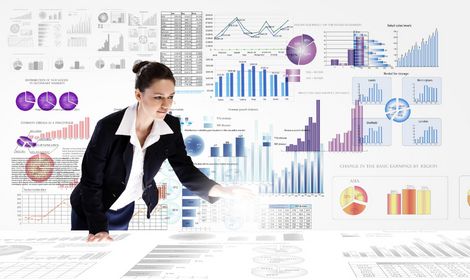Marketing Analytics
Using data to assess the efficacy and performance of marketing initiatives is known as marketing analytics. You may gain more comprehensive consumer data, optimize your marketing goals, and boost return on investment by incorporating marketing AI into your business plan. More than merely fancy technologies are needed for marketing analytics. Marketing teams require a plan that puts all of their data into context.
How does marketing analytics work for businesses?
Deciding on the metrics
Specify what you want your marketing to achieve in detail. Prioritize your marketing strategy's overarching objective before delving deeper into individual campaigns and distribution channels. Metrics may include brand recognition, conversion rate, click rate, or return on investment. Along the road, you should also establish benchmarks and milestones that will allow you to assess and modify your marketing strategies. Utilize a diverse range of analytical methodsAnalytical methods
You'll need a well-balanced selection of strategies and tools to maximize marketing analytics's benefits. Businesses can use marketing analytics to report on the past and analyze the present. Analyzing marketing data can help you forecast the future with data-driven predictions.Evaluating analytical skills
Given the abundance of marketing analytics technology, it can be challenging to determine which solutions are essential. But instead of starting there, consider your complete capability. To find your position on the analytics spectrum, evaluate your present abilities. Besides that, businesses can consider locating the gaps and devise a plan for bridging them.Campaign Optimization
With marketing analytics, you can create data-driven strategies to boost campaign performance and give your company an edge over rivals. The effectiveness of your A/B tests will increase, and you will be able to fine-tune them based on client data.Optimize email marketing
Using analytics, companies can optimize email marketing efforts and personalize them. Businesses can target email marketing and customize their communications to match client expectations and demands by studying how customers respond to various email promos.Social media engagement
Businesses now use social media as a primary marketing channel. Many analytics tools are available on social media platforms, such as Facebook Insights, Twitter Analytics, or any third-party channels or options. Analyzing social media data can provide valuable insights for building relationships with customers or businesses.Data Analytics
Any firm may expand and stand out from the competition with Hansvl's data analytics services and solutions. We find use cases to help you achieve your business priorities, and we develop analytics solutions using the best expertise and tools for your requirements. The future of your data is to be used to boost performance, resiliency, and growth for years to come.
Highlights
Data Analytics as a Service
Analytics as a Service (AaaS) provides a fully customized data analytics platform for in-cloud data analysis. With Hansvl, you can obtain enterprise-class analytics in the cloud without having to deploy and manage infrastructure. We create and manage a data warehouse (DWH), ELT/ELT, OLAP, reporting, and dashboarding, among other necessary components.Data Analysis
Businesses may get their data gathered, processed, and delivered to them in the form of valuable insights by using data analysis services rather than spending money on creating and managing an analytics solution.Consulting
A proprietary data analytics system can be designed, developed, implemented, and improved with the assistance of Hansvl's experts, who also assist you in selecting the best data analytics strategy. Data analytics consulting services help obtain insightful knowledge from data and transform it into a persistent competitive advantage.Implementation
We build and install an analytics system with the fundamental features to meet your present data analytics demands and scale up as they increase. Such components as DWH, OLAP cubes, data visualization, data science, significant data components, etc., may be included in your data analytics solution.Data analytics modernization
To maximize ROI and satisfy new data analytics requirements, Hansvl assists in upgrading the current data analytics solution.Data management services
To arrange your procedures for data collecting, storage, access, security, analysis, etc., Hansvl offers a solid data management framework. We promise consistency, accuracy, completeness, and auditability while setting up client data management.Risk Analytics
Risk analytics is a collection of techniques that accurately measures, quantifies, and anticipates risk. Managing risks has been a critical responsibility of management for decades. Using risk analytics, companies can develop a baseline to compare risk to many factors for the entire organization. Executives may have the clarity they need to recognize, assess, comprehend, and manage risks by consolidating several scenarios onto a single platform.
Highlights
Applying actionable protocols
Risk analytics eliminates the speculation and gives businesses actual data to develop actionable protocols. Organizations can apply a wide range of methodologies and technologies to the data to extract insights, investigate a variety of scenarios, and make forecasts.Data Integration
Every company collects considerable amounts of data from structured and unstructured sources. The business has access to all these data sources internally and externally. Managers may see, analyze, and provide actionable insights by bringing all this data onto a single platform using risk analytics.Scheduled Analytics and Testing
All data is accessible on a single platform. Organizations can use scheduled analytics to continuously audit and validate controls. Since the tests are automated, every red flag that is triggered notifies management, allowing users to move the problem straight into the solution stage.Decision-Making
Risk affects the entire organization, frequently across all administrative boundaries. Knowing what to do with risk-related insights might be difficult even when they exist. Organizations can use data sorting and risk analytics to identify problem trends and give management insight into potential dangers. Data insights are built on the foundation of risk analytics.Actionable Insights
It might be challenging to determine what to do with risk-related findings because the risk is such a broad factor that cuts across corporate boundaries. In this situation, risk analytics is crucial because it enables businesses to generate foresight regarding possible dangers and focus on difficulties that lay the foundation for actions.Establish influential programs
Analyzing operational and strategic decisions allows decision-makers to assess risks and benefits. Real and long-lasting value can be produced by offering insights into suggested actions to manage and avoid risks, from safeguarding return on investment and preventing expensive project overruns to enhancing overall program performance.Business Analytics
Business analytics is the discipline of continuously iteratively examining and analyzing historical business performance to obtain knowledge and drive future business planning. The many separate elements of business data analytics come together to produce insights. The process begins with the infrastructure for bringing that data in, even while business analytics solutions handle the aspects of crunching data and generating insights through reports and visualization.
Workflow
Data collection
Data must be collected and organized for access from all sources, including IoT devices, apps, spreadsheets, and social media. The gathering procedure is made noticeably simpler by using a cloud database.Data mining
Data must be organized and processed once it has arrived and been stored (often in a data lake). Data scientists can concentrate more on developing insights rather than tedious logistical activities by using machine learning algorithms to accelerate this process by identifying patterns and recurring operations, such as creating metadata for data from specific sources.Descriptive analytics
Descriptive analytics seeks out patterns and connections using both recent and historical data. Because it only describes trends and associations without going any further, it is frequently referred to as the most basic type of data analysis.Predictive analytics
Business analytics tools can begin to develop predictive models based on trends and historical context once they have sufficiently processed enough data and descriptive analytics. Thus, decisions in the future involving organizational and business choices can be informed by these models.Visualization
Visualization and reporting tools can help break down the numbers and models so that the human eye can quickly grasp what is being presented. Not only does this make presentations more accessible, but these types of tools can also help anyone from experienced data scientists to business users quickly uncover new insights.Big Data Engineering
Most businesses struggle daily with quintillions of bytes of data while trying to develop an information management plan that hastens the flow of insights. Their big data solutions are incredibly complicated, raising the cost of deployment and maintenance. Big data engineering focuses on making informed decisions that speed up business growth, not on using every piece of data from every source.





